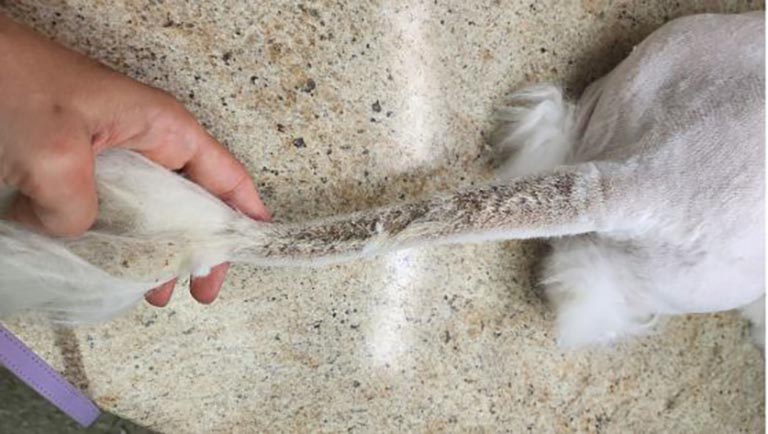Stud Tail is a condition that every cat owner should be aware of, as it can potentially lead to complications if left unmanaged. Understanding the causes, symptoms and treatment options for Stud Tail is crucial for keeping your cat healthy and comfortable. In this blog, we will delve into everything you need to know about Stud Tail, from its underlying causes and recognizable symptoms to effective prevention and treatment strategies.
Understanding Stud Tail
Stud Tail, also known as “tail gland hyperplasia,” involves the enlargement of the oil glands located near the base of a cat’s tail. Positioned on the upper side of the tail, a few centimeters from its base, these glands can become enlarged and overly active. This condition results in the glands compressing the nearby hair follicles and producing an excessive amount of sebum, an oily substance.
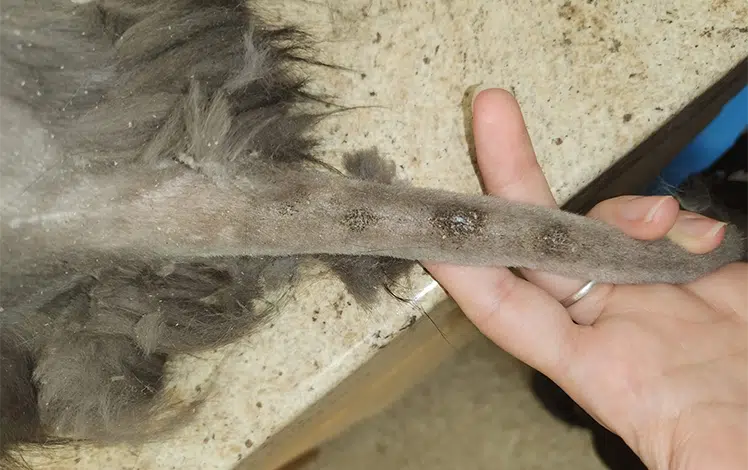
Causes of Stud Tail in Cats
Excess Testosterone
Stud Tail primarily results from an excess of androgen sex hormones, particularly testosterone. This hormonal imbalance stimulates the oil glands near the base of the cat’s tail, leading to their enlargement and overactivity.
Other Contributing Factors
Less commonly, seborrhea can also contribute to Stud Tail in cats. Seborrhea is a skin disorder characterized by excessive sebum production. This disorder may arise due to a cat’s genetics or from conditions such as allergic skin disease, skin parasites, hormonal imbalances or chronic yeast or bacterial skin infections.
Impact of Grooming
Poor grooming practices are often cited as a significant factor in the development of Stud Tail. Cats that are obese, have orthopedic issues affecting their mobility, experience stress or suffer from underlying illnesses may struggle to groom themselves effectively. This can exacerbate the accumulation of oils around the tail base, contributing to the development of Stud Tail.
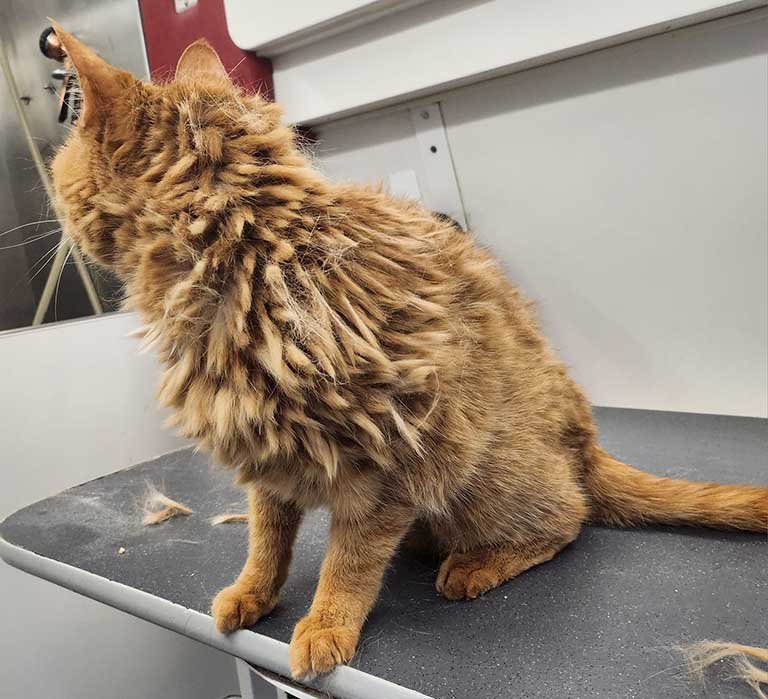
Which Cats Get Stud Tail?
This condition is more frequently observed in sexually mature male cats, particularly those that have not undergone neutering. While less common in females and neutered males, these individuals can still develop Stud Tail due to hormonal imbalances or other factors influencing glandular activity.
Stud Tail may be more prevalent in environments such as shelters or cat breeding facilities, where cats may experience higher stress levels or have limited opportunities for grooming due to overcrowding or other environmental stressors.
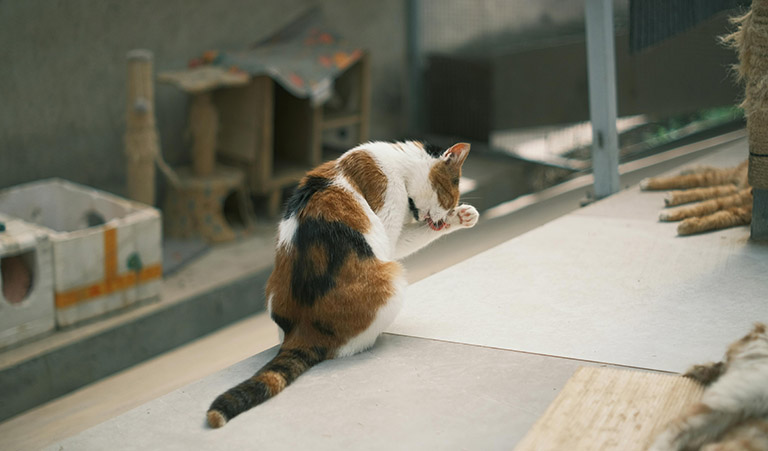
Symptoms of Stud Tail
Signs of Stud Tail in Cats
Stud Tail manifests with several noticeable signs that primarily affect the tail base. These signs include:
- Hair Loss and Greasy Fur: Hair loss typically occurs near the base of the tail, accompanied by greasy or oily fur due to excessive sebum production from enlarged oil glands.
- Discoloration: Light-colored fur near the tail base may take on a yellowish hue, indicative of the oily substance accumulating on the skin.
- Skin Changes: The skin around the affected area may become scaly, crusty or develop comedones (blackheads) due to the buildup of oils and skin debris.
- Hyperpigmentation: There may be areas of darkened skin (hyperpigmentation) around the tail base, reflecting ongoing glandular activity and skin irritation.
- Texture Changes: Over time, the affected skin can thicken and become bumpy, altering its normal texture.
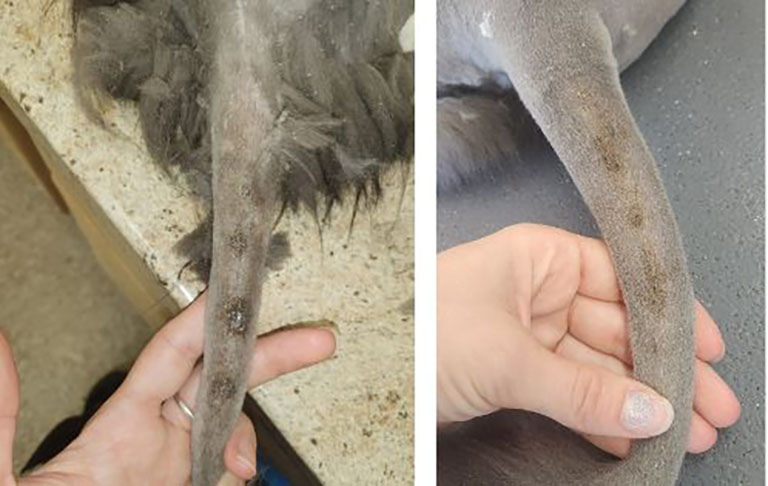
Complications and Secondary Infections
Stud Tail can lead to secondary complications, such as bacterial or yeast infections. These infections may cause:
- Inflammation: The skin may become red, swollen and warm to the touch.
- Discharge: Pus or other discharge may be present, especially if there are open sores or draining tracts.
- Itchiness: Itchy skin can lead to self-trauma, where the cat may excessively rub, chew or groom the affected area, exacerbating the condition.
- Extended Problems: In severe cases, the self-trauma can extend beyond the tail base, affecting larger areas of the tail or nearby skin.
Treatment Options
Stud Tail is primarily a cosmetic issue and generally does not cause significant problems for affected cats unless the area becomes inflamed or infected. Treatment is largely focused on maintaining hygiene and removing debris. For mildly affected cats, treatment may not be necessary, as the condition may only present as a cosmetic issue, such as a bald spot.
For most cases, management involves the use of shampoos and topical products containing benzoyl peroxide, salicylic acid or other degreasing agents. These products help to reduce oil buildup and keep the area clean.
Ask your groomer how they can help! Below are before-and-after images taken by one of our Master Cat Groomers, Amanda Henry, after she performed her stud tail healing magic!
If an infection is present, antibiotics will be required. Ideally, the selection of antibiotics should be based on the results of a bacterial culture to ensure the most effective treatment. In cases of infection, an e-collar may be necessary to prevent the cat from causing self-trauma by rubbing or chewing at the affected area. Additional supportive measures include weight loss, pain medication if needed and creating a stress-free environment to encourage normal grooming behavior.
Castration can help stop the progression of Stud Tail, although it may not completely resolve the issue. In severe cases where the infection is painful and unresponsive to treatment, amputation of the tail may be considered as a last resort.
Prevention
Regular Grooming
Preventing Stud Tail in cats involves a combination of regular grooming and proactive care. Regular grooming is essential, especially for cats prone to oily skin or those with longer fur. Brushing your cat’s fur helps to distribute natural oils more evenly and prevents the buildup of grease at the tail base. Using cat-friendly grooming products that include degreasing agents can also help maintain a healthy balance of oils on the skin. It’s also a good idea to ensure that your cat maintains a healthy weight, and addressing any mobility issues can improve their ability to groom themselves effectively.
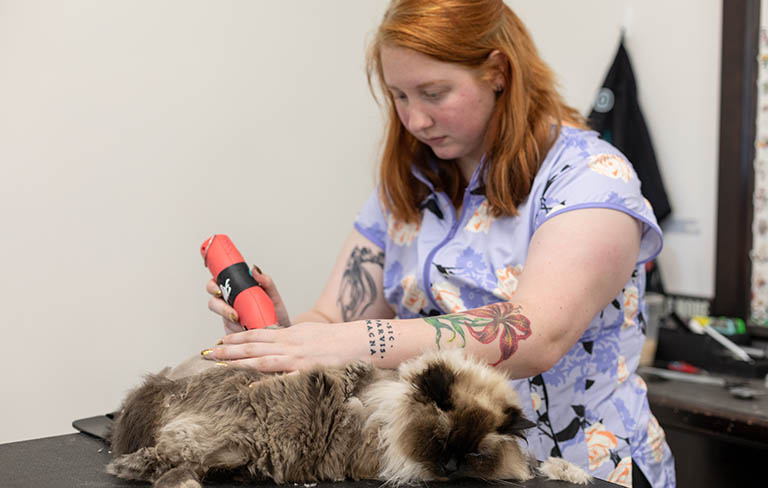
Regular Veterinary Visits
Regular veterinary check-ups play a crucial role in preventing Stud Tail. Routine visits allow for early detection of any skin issues or hormonal imbalances that might contribute to the condition. Your veterinarian can provide personalized advice on grooming routines and recommend appropriate products to use. They can also identify and treat any underlying health issues, such as seborrhea or other skin disorders, that might predispose your cat to developing Stud Tail.
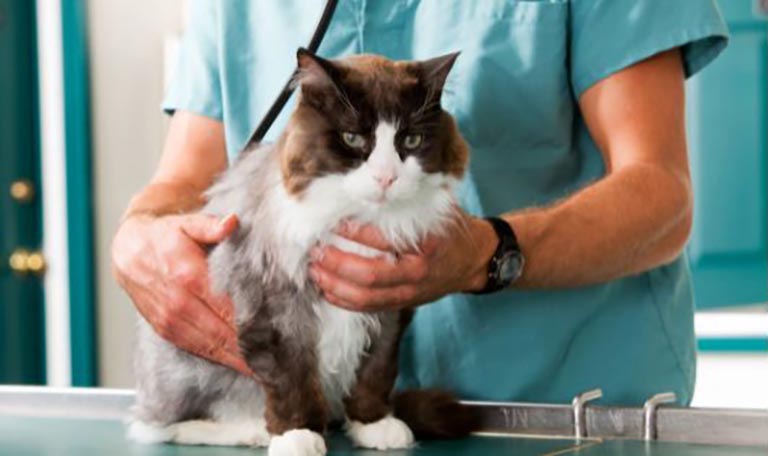
In Summary
Stud Tail is a condition that primarily affects the base of a cat’s tail due to overactive oil glands. While it is often a cosmetic issue, it can lead to more severe complications if left untreated. Regular grooming and veterinary check-ups are vital in preventing and managing Stud Tail. By maintaining good hygiene, using appropriate grooming products and addressing any underlying health issues, you can help your cat avoid the discomfort associated with this condition. Always consult your veterinarian for personalized advice and treatment options to keep your feline companion happy and healthy.


